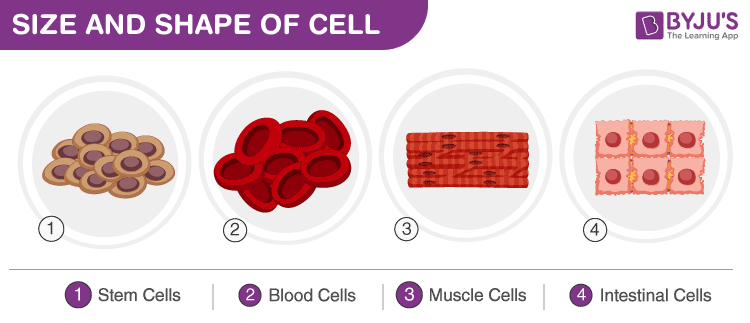As we know, the cell is the basic structural and functional unit of every living organism. As brick is to the building, the cell is to the body. The cell makes anything alive and enables a living organism to perform all its functions. It is self-sufficient to carry out all the fundamental functions of an organism. Robert Hooke is the first researcher to observe a cell using a magnifying device. Yes, cells are too tiny to see with our naked eyes. But not every cell is microscopic. Within our body, we can observe a variety of cells of different shapes and sizes. Let’s discuss more, the number and the variety of shapes and sizes of cells in different organisms.
Number of Cells
Cells are the lowest level of organization in every life form. From organism to organism, the count of the cell may vary. Humans have more cells than bacteria. If an organism is made up of a single cell, it is called a unicellular organism(uni: one; cellular: cell). Whereas, the organisms which are made up of more than one cell are called multicellular organisms (multi: many; cellular: cell). Among multicellular organisms, the count of the cell varies. Some might have billions of cells while others have trillions (like the human). But every organism starts its life from a single cell which further divides into thousands and millions.

As the size of the organism increases so does the number of cells that they have. However, this count will not determine the efficiency of an organism i.e., the function and efficiency of a cell in a unicellular organism and multicellular organism will be the same.
Read: Unicellular vs Multicellular Organisms
Sizes and Shapes
Living organisms are made up of different types of cells, of different shapes and sizes. A unicellular organism differs in shape from another unicellular organism. Within a multicellular organism, there are a variety of cells. Some are long while others are short; some are circular while some are oval. Shape and size vary from cell to cell according to their functions and composition. For example, a nerve cell is long and branched, meant for the transmission of signals throughout our body while a muscle cell is small and spindle-shaped which helps in movement.

Considering an animal cell, we can generalize the shape of a cell as round (spherical) or irregular. Plant cells are much more rigid and rectangular in shape. The size of a cell can be as small as 0.0001 mm (mycoplasma) and as large as six to twelve inches (Caulerpa taxifolia). Generally, the unicellular organisms are microscopic, like bacteria. But a single cell like an egg is large enough to touch. Whether regular or irregular in shape, they all consist of the same organelles and help us to perform the daily activities efficiently.
To learn more about the cell and its organelles, visit BYJU’S Biology.
Also Read:
Frequently Asked Questions
What determines the shape and size of cells?
The cytoskeleton, the amount of water in the cell and the state of the cell membrane are the three main factors that determine the shape and size of cells.
What influences cell size?
The timing of cell division and the balance between cell growth influences the size of a cell.
Why do cells increase and decrease in size?
When a cell grows, its internal volume begins to increase, but the surface area remains the same. Therefore, the cells have a decreased surface area to pass materials as compared to their volume.

Good answer thanks
I like those answer. …..
Besttt explanation😄